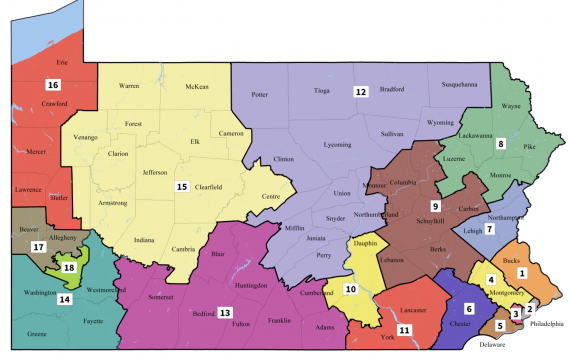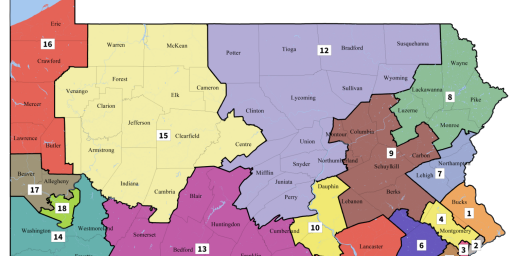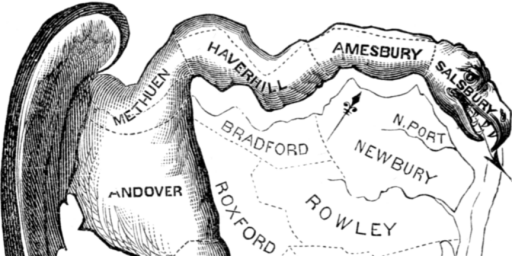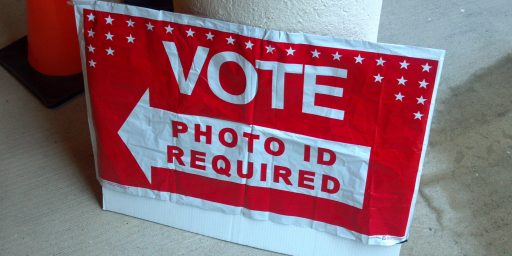Opponents Of New Pennsylvania Redistricting Map Suffer Two Big Setbacks In Court
Challengers to the Pennsylvania Supreme Court's ruling on Congressional redistricting suffered two big setbacks in court yesterday that suggest that they've reached the end of the road legally.
Just under two months ago, the Pennsylvania Supreme Court issued a ruling finding the current Congressional District map, drawn by a Republican-dominated state legislature in the wake of the 2010 election and the reapportionment of seats in the House of Representatives that followed the 2010 Census to be unconstitutional under the terms of the state’s Constitution. In the Order it issued at the time, the Court gave the state legislature a limited amount of time to come up with a new map that was compliant with both the state’s Constitution and the State Supreme Court’s ruling. At first, the Republican legislature responded by taking the matter to the U.S. Supreme Court, asking the Court to put the state Supreme Court’s ruling on hold, the Supreme Court declined to do so. The state Supreme Court also stated that it would submit a map of its own if the legislature proved unable to come up with an acceptable map by the time the deadline passes. That deadline passed with the legislature and the state’s Democratic Governor unable to come up with a map that either side could accept, so the state Supreme Court ended up creating a map of its own that would likely mean real gains for Democrats in a Congressional delegation that has been dominated by Republicans since 2010.
Yesterday, though, the opponents of the state Supreme Court’s ruling suffered a series of setbacks in Federal Court that likely means an end to the challenges:
Just one day before congressional candidates had to file nominating petitions, the U.S. Supreme Court in Washington and the federal District Court here both declined on Monday to grant requests from Republicans to block the new Pennsylvania congressional district map from going into effect for the May 15 primary.
By improving Democrats’ chances of picking up seats in an important swing state, the new map has already changed the landscape for the congressional elections, with more people expressing an interest in running and some veteran politicians reconsidering their chances of success.
The courts’ decisions on Monday disappointed Republicans —some of whom will likely face a tougher path to re-election — and delighted Democrats, who are hoping to regain control of the House.
“For anyone who cares about democracy, for anyone who cares that every voter’s voice should be heard, this is a great day,” said Mimi McKenzie, legal director of the Philadelphia-based Public Interest Law Center, which represented the Democratic voters who brought the initial suit that prompted the redrawing of the congressional map.
Top Republicans in the state House and Senate seemed resigned Monday to the idea that it was the end of the road for their effort to stop the map.
“I’m sure we’ll review options, but I think we’re accepting the decision,” said Senate Majority Leader Jake Corman (R., Centre), who along with others brought the U.S. District Court challenge. “[We] don’t like it, but that’s life and we move on.”
In a one-sentence filing, the Supreme Court declined late Monday afternoon to intervene in the case. The justices did not offer an explanation for their unanimous decision.
Resignation or glee — depending on political affiliation — then appeared to set in at the Capitol.
State House Speaker Mike Turzai (R., Allegheny), one of two legislative leaders who appealed to the Supreme Court, said in a statementthat he still believes the Pennsylvania Supreme Court overstepped its bounds when it imposed the new map last month.
“Nonetheless, we respect the decision of the U.S. Supreme Court and are prepared to move on to other issues of importance to the people of Pennsylvania,” he said.
(…)
Earlier in the day, the U.S. District Court rejected the challenge filed by eight congressmen and two state senators, who argued that the state Supreme Court, when it imposed a new map last month, violated the Elections Clause of the U.S. Constitution, which grants state legislatures the power to oversee elections.
In a 27-page set of filings, the judges said that the Republican lawmakers did not have standing: The argument that the Pennsylvania Supreme Court stepped on the legislature’s rights should be brought by the entire General Assembly, not by two of its members or a group of congressmen, the court said.
“The plaintiffs are neither the Pennsylvania General Assembly nor a group to which Pennsylvania has delegated the commonwealth’s lawmaking power,” the judges wrote. “As far as we can tell on this record, the Elections Clause claims asserted in the verified complaint belong, if they belong to anyone, only to the Pennsylvania General Assembly.”
The judges wrote that the court was not in a position “to opine on the appropriate balance of power between the commonwealth’s legislature and judiciary in redistricting matters, and then to pass judgment on the propriety of the Pennsylvania Supreme Court’s actions under the U.S. Constitution.”
The judges said that the issues raised in the case were “of high importance to our republican form of government” and that they understood the GOP’s frustration. “But frustration, even frustration emanating from arduous time constraints placed on the legislative process, does not accord the plaintiffs a right to relief,” they wrote.
The three judges — Chief U.S. District Judge Christopher C. Conner for the Middle District of Pennsylvania, Judge Kent A. Jordan of the U.S. Court of Appeals for the Third Circuit, and District Judge Jerome B. Simandle for the District of New Jersey — all were appointed by Republican presidents and confirmed with bipartisan Senate support.
As is typically the case, the Supreme Court’s decision to not stay the state Supreme Court’s did not come with a written opinion of any kind explaining the Court’s ruling, but simply via a one-sentence ruling stating that the request for a stay had been denied. Effectively, though, this means that the state Supreme Court’s ruling will remain in effect and that its map will be the one that the race for Congress in the Keystone State will be based on this year. Theoretically, it’s still possible that the losing side in the underlying state Supreme Court ruling could seek to have their case reviewed by the nation’s highest court, but it seems unlikely at this point that the Justices will be inclined to accept the case. The main reason for that, of course, is that the underlying decision was based on state law and the state Constitution. In such situations, the Supreme Court is generally reluctant to question the ruling of a state’s highest court unless Federal law or the Federal Constitution is implicated in some way. While the legislators challenging the ruling do apparently raise some federal claims on appeal, it seems apparent that the Justices don’t find that argument persuasive. Additionally, the fact that the Court has rejected two requests to stay the underlying ruling, including this most recent one that comes just days before the filing deadline for the upcoming May primaries, suggests strongly that it would reject an appeal of that ruling.
The second ruling from a three-judge panel of Federal Judges in Harrisburg also seems unlikely to be going anywhere. In that case, the challengers did raise Federal law claims against the underlying state Supreme Court ruling as well as claims based on state law. In their ruling, the three-judge panel appointed to hear the case ruled that the challengers before them did not even have standing to challenge the underlying ruling and therefore did not reach the merits of the decision itself. The Plaintiff’s could seek to appeal this ruling directly to the Supreme Court, which is the proper procedure cases involving three-judge panel District Court rulings, but that avenue is as likely to be unsuccessful as the efforts to get the Justices to review the ruling of the Pennsylvania Supreme Court has been. In theory, this leaves open the possibility that some group of Plaintiffs who do have standing, the three-judge panel suggested that the state’s General Assembly could theoretically have such standings, could challenge the ruling, but that would require a whole new lawsuit and a new round of pleadings. Given the fact that the deadlines for the upcoming primaries are fast approaching, though, I tend to agree with Lyle Denniston that it’s likely that this pair of rulings yesterday marks the end of the legal road for challenges to the state Supreme Court’s ruling.
As a practical matter, this means that the map drawn by the Pennsylvania Supreme Court will be the one that governs the upcoming midterm elections in the state and, unless there is some intervening act, the 2020 Congressional elections in the state as well. This is likely to inure to the benefit of Democrats in a year where the battle for control of the House of Representatives is already at a fever pitch. Presently, the Pennsylvania Congressional delegation consists of 12 Republicans and 5 Democrats. Assuming that Conor Lamb’s narrow victory last week is certified, that will soon become 12 Republicans and 6 Democrats. Political observers in Pennsylvania estimate that the redrawn map could lead to Democrats picking up at least 3 or 4 seats in November even under normal circumstances. In an election year like the one we appear to be headed toward, it could mean even bigger Democratic gains in the Keystone state that would play a big role in adding to the total number of gains Democrats need to regain control of the House after eight years in the minority.
Here’s the opinion of the three-judge panel:
Cornan et al v, Torres et al Opinion by Doug Mataconis on Scribd






That’s what you get for being greedy. The GOP could have redrawn the map to still be biased but not so freaking blatant. They could have sacrificed a few neighborhoods or even a district and still kept their hold. Nope – like an entitled brat, they refused to play fair, refused to participate when asked and are now throwing tantrums left and right at what the adults created without their input.
You had your chance, GOP -more then one, in fact. Too bad you wasted them being petulant. A smart group would have submitted a map that kept them in power or at least still favored them but that would have required cooperation. You can’t keep complaining about how unfair everything is if you refuse to participate in the process to make it better.
Good. The only sad thing is it took so long. Now, hopefully, the people of Pennsylvania will be properly represented in Congress.
@KM:
Indeed, the map the court drew still has a GOP bias, just not as bad as before:
Pennsylvania’s New Map Helps Democrats. But It’s Not A Democratic Gerrymander.
Should redistricting be a job for an AI?
@Stormy Dragon: Indeed. The court was probably going for an obviously fair map. Even though the court is Dem, going for a Dem gerrymander would have been overreach. And everyone would tell us that it has to favor republicans because Dems are packed close together in cities. This is a pet peeve of mine.
There’s no law that says you have to redistrict on a Mercator projection map. (The usual map, where area represents area, except Greenland looks bigger than Europe.) Use a cartogram where area on the map represents population. The sort of map you see after each presidential election to explain that no, the U.S. is not really all red. On such a map the cities of Philadelphia and Pittsburgh would look like what they are, 15% of the state. The two metro areas are and would look like 60% of the state. At that point cities can be treated like anywhere else. Maybe your rule is start in the SE corner of the state and draw a box that incorporates 1/17 of the population. If that box more or less runs down 3rd Ave., jigs down Elm St for 3 blocks, and continues on 6th Ave., so be it.
It’s only gerrymandering when the other side does it.
#LuisGutierrez
@michael reynolds:
Yes.
But AI’s have politics as well (or rather the parameters/algorithms have politics based on the decisions made by their programmers). So the bigger issue is to get balanced parameters for determining districts. And that goes back to the responsibility of each state to agree on those.
@mattb: I know people have given this some serious thought. Surely it’s not that difficult to form n clusters based on centers of population densities, and surely that would be a fair approach to the problem?
Meanwhile, in response to losing before the courts, a Republican legislator is making good on his threat to begin impeachment proceedings against the State Supreme Court justices.
@reid:
There are a LOT of models out there. The devil tends to be at the micro level (and the often unintended consequences of those decisions).
My broader point — and it’s a critical one — is just to call out that AIs and Algorythms are never bias or politic-free. That’s going to be a critical thing for us to remember going forward (as there will be an ever increasing tendency to try to “take the politics/humans” out of situations like these by using algorithms).
Thought I’d pass on Kevin Drum’s headline on this story: The Pennsylvania Gerrymandering Case Is Over. The Good Guys Won.
@michael reynolds:
You don’t need the A; ordinary I will do. This is a venerable problem in the field I got my degrees in. See for example this paper from 1965…
@mattb:
That’s why you want a transparent algorithm for this, not machine learning. If the objective is understood by everyone and inarguable, then the rest is just math. “Explainable AI” is a thing precisely because sometimes transparency matters, and an algorithm that optimizes a known objective is preferable to a ‘better’ algorithm that optimizes an unknown objective.
@DrDaveT:
100%
Transparency is critical and the best way to help deal with the issue of hidden potential biases.
Today is the vernal equinox. Happy First Day of Spring!
Illinois Primary Election Results.
81% of precincts reporting.
Democratic Primary for Governor.
1,109,000 votes cast among 6 candidates.
JB Pritzker wins with 49.5% of thr votes.
Republican Primary for Governor
588,000 votes cast between two candidates.
Incumbent Bruce Rauner 51.7%
Jeanne Ives 48.3%
It ain’t over yet for the GOP.